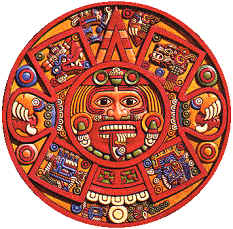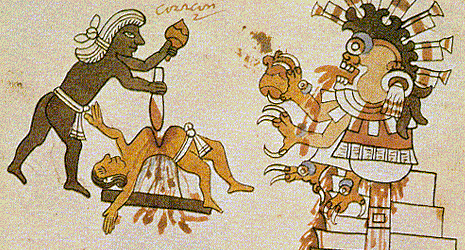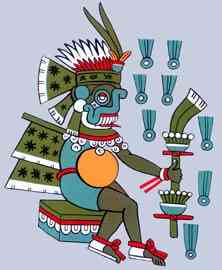l992
Dr. Jane S. Day, Chief Curator
Denver Museum of Natural History
 AZTEC RELIGION
AZTEC RELIGION In the Aztec capital of Tenochtitlan religion dominated the daily life of the people. Its activities centered around the many temple complexes of the city. In the small neighborhood temples and on the massive pyramid structures at the central sacred precinct elaborate rituals were performed daily. Here priests served the large pantheon of powerful Aztec gods. These gods controlled human fate and the destiny of the empire. Indeed the intricate balance of the universe itself depended upon their good will. To insure that life would survive and that the gods would be favorably inclined, ceremonies were performed in their honor which involved gifts of incense, food, birds, and animals, as well as the sacrifice of human beings whose hearts and blood were considered the supreme offering.

The many religious ceremonies which permeated the daily life of elite and commoners alike were the symbolic link through which the Aztecs sought to propitiate their gods. Each year throughout the religious calendar cycle people were called upon to participate in ritual performances that empowered the demanding deities. These performances included music, poetry, costume, dance and drama as well as priestly activities and sacrifices.

 HUITZILOPOCHTLI
TLALOC
HUITZILOPOCHTLI
TLALOC
Aztec religion focused on three themes of prime importance to the empire, each incorporated a group of deities who needed to be constantly nourished. These themes were: celestrialprimordal creation; rainagriculturefertility and warsacrifice. In addition certain gods within Aztec society were patrons of specific groups. For example Tezcatlipoca, the everyoung, all powerful shaman was the special deity of the Aztec kings, while Xipe Totec, who wore the flayed skin of a sacrificial victim, was the protector of goldsmiths. Above all towered the two gods who were worshiped on the top of the great Templo Mayor in the central precinct of the city, Huitzilopochtli, patron god of the Aztecs and god of war, and Tlaloc, god of rain and fertility. These were the symbols of the sustaining forces of the Aztec empire, agricultural products and tribute.
At the heart of Aztec religion lay the belief that in the past the world had been created and demolished by the gods four times. At the end of each era the sun was destroyed and the earth depopulated. The Aztecs believed that their own world, the 5th sun, was created at the ancient site of Teotihuacan through the sacrifice of a god who flung himself into a fire in order to reappear in the sky as the sun. This sun, however, was unable to move across the heavens until other gods also sacrificed themselves by providing their own blood as sustenance for the movement of the sun. The human sacrifices, which were the focal point of many religious rituals, symbolized the continual effort of the Aztec people to repay this blood debt to the gods, to provide energy for the movement of the sun across the sky and to prevent their own world of the 5th sun from coming to an end.